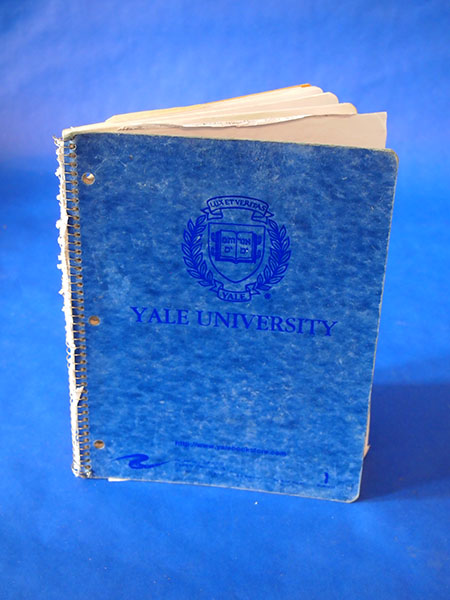![]() body | color | collections | commodity | cube | document | fabric | fetish | gender | glass | home | identity | living | machine | metal | minimal | mobility | narrative | olfactory | organic |
body | color | collections | commodity | cube | document | fabric | fetish | gender | glass | home | identity | living | machine | metal | minimal | mobility | narrative | olfactory | organic |
![]() pain | paper | plastic | plugs | power | protective | rectangular | ritual | round | sound | souvenir | spiritual | style | text-based | time | tool | touch | uniform | value | visual | warm | wood
pain | paper | plastic | plugs | power | protective | rectangular | ritual | round | sound | souvenir | spiritual | style | text-based | time | tool | touch | uniform | value | visual | warm | wood
| Paper: Large Blue Yale University Notebook | |||
Narrative: Large blue Yale University notebook The paper was made from pulp obtained by chemical means, known as kraft pulping. Chips of wood were placed in a large, sealed container known as a digester. The digester contained a strongly alkaline solution of sodium hydroxide and sodium sulfide. Bleaching removes lignin and involves mixing the pulp with a series of oxidizing chemicals that react with the lignin. After each mixture, the pulp was washed with an alkaline solution that removes the treated lignin. Fillers were added to the pulp. (A typical filler is a clay known as kaolin. Other chemicals often added to pulp include starches or gums. Rosin and alum are often added as sizers, making the paper less absorbent.) Pulp was added to water to form slurry in order to make paper with an even density. The slurry was pumped onto a moving mesh screen made up of very fine wires of metal or plastic. Water drained through the small openings in the mesh, and formed a sheet of wet material from the slurry. The sheet was moved on a series of belst made of felt containing wool, cotton, and synthetic fibers. The dried sheets moved between rollers known as calendars to make it smooth. Large untrimmed sheets of cardboard (for the back), paper (often printed with rules) are stacked. A laser-controlled guillotine is used to trim these sheets to make several unbound notebooks, a separate machine is used to die-cut the binding holes across the top or left margin. A spiral binding is wound in like a screw, cut and folded at the edge of the notebook. Frequently the spiral is replaced with a comb binding which is similar but, because it does not need to be screwed in is quicker. This notebook was given to me at a fellowship at Yale School of Art in 2001. I used this notebook during the summer and fall of 2001. It traveled with me from Connecticut to Brooklyn to Queens to storage. Then it was retrieved and traveled to Manhattan and Brooklyn.
|
 |
||
![]()
